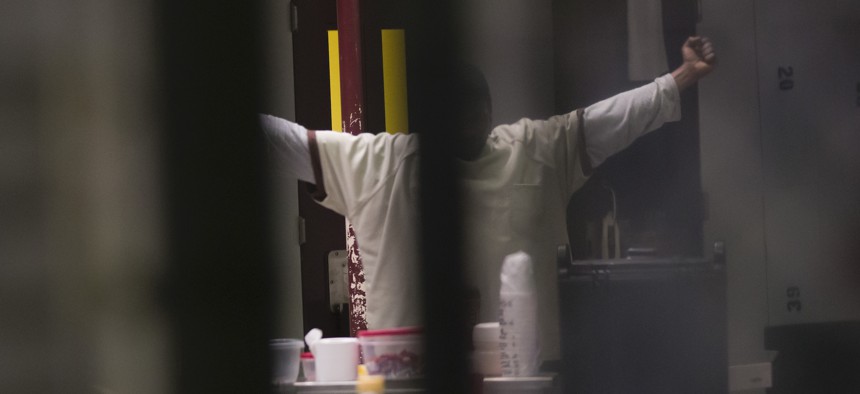
In this photo reviewed by U.S. military officials, a detainee, name and facial identification not permitted, stretches inside the Camp VI detention facility, Wednesday, April 17, 2019, in Guantanamo Bay Naval Base, Cuba. AP / Alex Brandon
We Haven’t Done Enough to Ensure That America Never Tortures Again
The first post-9/11 commander of the Gitmo detention facility maps out what’s done and what still needs doing.
Torture in secret overseas CIA “black sites.” A cover-up by the government followed by a courageous congressional investigation. A Senate report that many thought would never see the light of day — yet which shocked lawmakers and a U.S. president into trying to ensure that such crimes can never again be committed in our names. All this sounds like the plot of a Hollywood movie — and indeed it is: The Report, starring Adam Driver, Annette Bening, and Jon Hamm, and opening this Friday. But the movie, in fact, is a remarkably accurate and powerful accounting of a sad and regrettable chapter in American history — and an important step in our national reckoning.
In the wake of the 9/11 attacks, the Bush administration chose to disregard longstanding legal prohibitions against torture. I know because I was there, as the first commander of the detention facilities at Guantanamo Bay, Cuba. I and many others did what we could to preserve the rule of law, but the darkest of chapters were written beyond the knowledge of even senior military officers.
Officials authorized so-called “enhanced interrogation” techniques that CIA officers used on detainees at black sites and Guantanamo Bay. These techniques, along with a prevailing “take-the-gloves-off” approach, migrated to Iraq, where they spawned horrific freelance abuse at Abu Ghraib and elsewhere.
When the abuse came to light in 2004 and 2005, a coalition of retired military leaders formed to oppose torture. I was a proud member of the coalition, and still am. While some were surprised to see retired generals and admirals speaking out on a hot-button issue, I saw our advocacy as an extension of our military service: We were once again championing American ideals, just in a new capacity. Our coalition helped win an important victory in 2009 when President Obama signed an executive order banning torture. We later pressed for release of the Senate’s torture report, which set the stage for the Senate’s overwhelming, bipartisan passage of the 2015 McCain-Feinstein amendment that strengthened and clarified the ban.
Related: Guantanamo Is Becoming a Nursing Home for Its Aging Terror Suspects
Related: When China Convinced the US That Uighurs Were Waging Jihad
Related: As ISIS Fight Winds Down in Syria, Detainee Numbers Are Rising
Though I am proud of our coalition’s accomplishments, its mission is not complete. Our country must now take the next step: consolidating a durable consensus against torture and ensuring that the United States never again adopts these brutal practices. This task is especially important right now, considering that America’s next generation of military and national security leaders were young and largely—though understandably—unaware of the CIA’s abuses as they unfolded in real-time.
So, what are the lessons that need to be cemented? Despite what its apologists may claim, I can say with confidence based on my military experience that the use of torture weakened U.S. national security, in numerous ways. First of all, it’s ineffective. Rapport-based techniques are the best way to provide valuable intelligence that is useful to soldiers, whereas torture leads detainees simply to tell interrogators what they think the interrogators want to hear. But beyond its ineffectiveness, torture proved counterproductive, causing America to suffer investigative setbacks, exhaust precious resources, and send service members into harm’s way—all on the basis of bogus information. It helped terrorist groups by giving them material for propaganda and recruitment. It alienated allied countries and populations whose support the United States needs in the fight against terrorism. It has compromised our ability to bring those responsible for the 9/11 terrorist attacks to justice. And it generally tarnished the credibility that the United States relies on to pursue national security and strategic objectives. More importantly, however, it was immoral and sharply diverged from the very American values that our service members defend.
The 2020 presidential election presents an opportunity for candidates to advance this discussion and work toward building a permanent consensus against torture. Fortunately, there is no shortage of concrete ideas. They should read and absorb the executive summary of the report, if they have not done so already. They should commit to publicly releasing the full Senate torture report — just 525 of its 6,700 pages have been released — so that America can understand the full extent and ramifications of the CIA’s past abuses. They should commit to distributing the full report throughout the executive branch to ensure its lasting preservation. And they should commit to refusing to appoint, nominate, or retain in their administration anyone who was involved in managing, directly carrying out, or providing legal authority for the torture program. Of course, much more must be done to establish an enduring, nationwide norm against a return to torture, but these measures represent a meaningful step in the right direction.
Having served a full career in the military, I understand the importance of fully accomplishing the mission. As a country, we must strive to do so in the context of torture. It is time to ensure, once and for all, that there is no place in America’s future for a return to torture.




